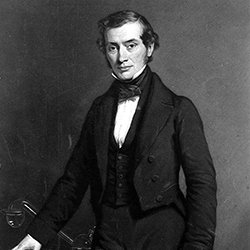Thomas Graham - Formulated the Law of Diffusion of Gases
Few people can truly claim to have impressed one of the world’s finest scientists by the age of 14. Thomas Graham could. Despite battling with personal tragedy and a nervous disposition throughout his 64 years, Graham nonetheless succeeded in leaving his mark on the world.
'Graham's Law'
Born in Glasgow in 1805, Thomas Graham joined Anderson’s Institution (now the University of Strathclyde) as a Professor of Chemistry in 1830.
The 29 research papers Graham published during his time at Anderson’s Institution laid the groundwork for his international reputation. In 1833 he published 'On the Law of the Diffusion of Gases', a ground breaking work. Today, this discovery is known as ‘Graham’s Law’.
Master of the Mint
Graham moved to London after seven fruitful years at Anderson’s Institution and became a Professor of Chemistry at the recently-founded University College. He went on to further greatness – by 1844 he was recognised as the leading chemist in England.
He remained at University College until 1854, when he followed in the footsteps of Newton in his appointment as Master of the Mint.
A lesser well known fact is that Graham also invented the forerunner of today's dialysis machine in 1861. He invented what he called a ‘dialyzer’ to separate colloids and crystalloids. The method of separation is exactly that used in modern-day dialysis to separate urea from blood, while his ‘dialyzer’ predates the dialysis machine that plays a vital role in the treatment of kidney disease.
Thomas Graham’s pioneering work is commemorated with a statue in George Square, and the Thomas Graham Building at the University of Strathclyde houses the Department of Pure & Applied Chemistry. Greatly admired by his peers, one obituary declared:
It might be difficult to find in history a character so perfect in its nobic simplicity and elevation… a man whose name will be honoured as long as true greatness is appreciated.”
